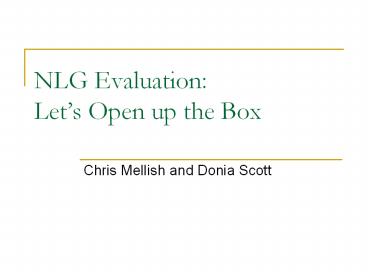NLG Evaluation: Let - PowerPoint PPT Presentation
Title:
NLG Evaluation: Let
Description:
NLG Evaluation: Let s Open up the Box Chris Mellish and Donia Scott – PowerPoint PPT presentation
Number of Views:85
Avg rating:3.0/5.0
Title: NLG Evaluation: Let
1
NLG EvaluationLets Open up the Box
- Chris Mellish and Donia Scott
2
End to End Evaluation
- Start from some available, neutral data, e.g.,
numbers - End with simple text
- Measure text fluency and/or accuracy
- Appealingly simple idea
- Minimal constraints anyone can play
3
Problems
- Can overfit the task the solutions may not be
interesting - What does this have to say about NLG in general
(i.e. the things we talk about at conferences)? - May attract few serious participants, because of
lack of perceived relevance
4
Opening the Box
- End-to-end evaluation is a black box approach,
which sheds no light on what is happening in the
systems - Is there no prospect for white box evaluation
that sheds light on how best to do general NLG
tasks?
5
The MUC experience
- MUC-1 no formal evaluation
- MUC-2 template filling
- MUC-3,4 more complex templates
- MUC-5 nested templates
- MUC-6 added named entities, some
domain-independent templates, coreference - WHY THE CHANGE?
6
The MUC5/6 Transition
- demonstrating task-independent component
technologies of information extraction which
would be immediately useful - while so much effort had been expended, a large
portion was specific to the particular tasks. It
wasnt clear whether much progress was being made
on the underlying technologies which would be
needed for better understanding - (Grishman and Sundheim, COLING-96)
7
How fast can we open the box?
- It took MUC 8 years from MUC-1 to MUC-6
- Do we have that long?
- Do we have the funding/commitment to learn slowly
through experience?
8
Can we open it?
- Do we agree on enough? Isnt NLG riven by
controversy and disagreements? - The RAGS project showed that there is a basis for
agreement, though its not simple - RAGS gave a way formally to define complex NLG
interfaces
9
The RAGS model
10
Devising a whiteish box
- Devise some example end-to-end NLG task
- Choose certain internal interfaces
- Formalise these interfaces, e.g., using RAGS or
something that improves it. - Devise an XML format and create example data/
requirements for data to be produced - Make using that format a condition of
participation
11
Why start from RAGS?
- It exists, has been tried, is based on existing
NLG work - It is very flexible (can describe complex mixed
and partial structures) - It provides an XML interchange format
- RAGS can be (and should be) reinterpreted in
terms of the semantic web. This would bring
access to many generic tools.
12
The reinterpretation
- RAGS abstract type definitions (upper)
ontologies (e.g., using OWL) - Agreed instantiations (lower) ontologies
- XML offline representation better to use RDF
representation - Native formats RDF input/output models provided
by most programming languages
13
RAGS as the Les Demoiselles d'Avignon of NLG
ugly!!
A veritable cataclysm!!
Scandalous!!
Shocking!!
A horror!!
- long recognized as one of the most significant
paintings of the twentieth century - represents a revolutionary breakthrough in the
history of modern art - a pivotal work in the development of modern art
14
(No Transcript)
15
(No Transcript)
16
Lets open the box!
- This may not lead to the easiest game to devise
or play, but it may lead to a much more
meaningful one. - Which would be most fun?































